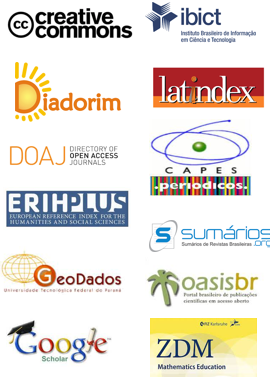Some Short and Important Explications about Semiotics
DOI:
https://doi.org/10.17921/2176-5634.2019v12n3p268-274Resumo
That language is essential to the human nature has never been doubted. However, nowadays it becomes more and more obvious that language is not enough to characterize our destinations, because the relationship between nature and society seem essential when reflecting on the development or destination of humanity. Starting from the belief that semiotics provides the basis of a new conceptualization and understanding of humanity in its relations to nature as well as within the context of social history this paper tries to introduce some related semiotic concepts and provide basic orientations for further research in the philosophy of science as well as cognitive theory.
Keywords: Saussure. Peirce. Semiotics. Complementarity of intension and extension.
Resumo
Que a linguagem é essencial para a natureza humana jamais foi posta em dúvida. No entanto, atualmente torna-se cada vez mais evidente que a linguagem não é suficiente para caracterizar nossos destinos, pois a relação entre natureza e sociedade parece essencial para refletir sobre o desenvolvimento ou destino da humanidade. Partindo da crença de que a semiótica fornece a base de uma nova conceituação e compreensão da humanidade em suas relações com a natureza, bem como dentro do contexto da história social, este artigo busca introduzir alguns conceitos semióticos relacionados e fornecer orientações básicas para futuras pesquisas na filosofia da ciência, assim como na teoria cognitiva.
Palavras-chave: Saussure. Peirce. Semiótica. Complementaridade de intensão e extensão.
Referências
Aristotle. (2004). Rhetoric. New York: Dover Publ.
Augustine. (1958). On Christian Doctrine. (D. W. Robertson, Trad.) Indianapolis: Liberal Art Press.
Brent, J. (1993). Charles Sanders Peirce, A Life. Bloomington: Indiana University Press.
Deely, J. (1982). Introducing Semiotic. Bloomington: Indiana University Press.
Finegan, E. (2012). Language: Its Structure and Use (6 ed.). Boston: Wadsworth - Cengage Learning.
Frege, G. (1884). Grundlagen der Arithmetik: Eine logisch mathematische Untersuchung über den Begriff der Zahl. Breslau: Wilhelm Koebner.
Frege, G. (1969). Funktion, Begriff, Bedeutung: Fünf logische Studien. Göttingen: Vandenhoeck & Ruprecht.
Galileo, G. (1623). The assayer. Fonte: https://it.wikisource.org/w/index.php?title=Il_Saggiatore/6&oldid=818600.
Mayr, E. (2002). What Evolution Is. New York: Basic Books.
McGinn, C. (2000). Logical Properties: Identity, Existence, Predication, Necessity, Truth. Oxford: Oxford University Press.
Nahin, P. J. (1998). An Imaginary Tale: The Story of √ −1. Princeton: Princeton University Press.
Otte, M. (1995). La philosophie des mathématiques de Charles Peirce, in: M. Panza/ J. C. Pont (org), Les Savants Et L’epistemologie Vers Le Fin Du XIX Siecle. Paris: Blanchard.
Otte, M. (2018). Semiotics, Epistemology, and Mathematics. Em N. P. et.al., Signs of Signification: Semiotics in Mathematics Education Research (pp. 155-171). Nova York: Springer International Publishing.
Peirce, C. S. (1931-1935 & 1958). CP = Collected Papers of Charles Sanders Peirce (Vol. I-VI, ed. by Charles Hartshorne and Paul Weiß, 1931-1935, and Vol. VII-VIII, ed. by Arthur W. Burks, 1958 ed.). Cambridge: Mass. (Harvard UP).
Peirce, C. S. (1931-1935 & 1958). CP = Collected Papers of Charles Sanders Peirce. Vol. I-VI, ed. by Charles Hartshorne and Paul Weiß, Cambridge, Mass. (Harvard UP) 1931-1935, Vol. VII-VIII, ed. by Arthur W. Burks, Cambridge, Mass. (Harvard UP), 1958.
Searle, J. R. (1979). Expression and meaning: Studies in the theory of speech acts. Cambridge, London, New York, Melbourne: Cambridge University Press.
Wittgenstein, L. (2001). Tractatus Logico-Philosophicus. London and New York: Routledge Classics.
Zilsel, E. (2003). The social origins of modern science. Dordrecht: Kluwer.


